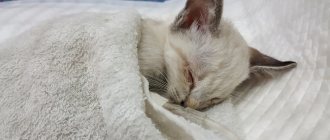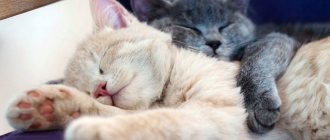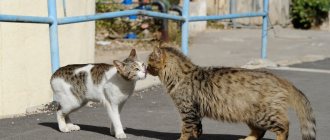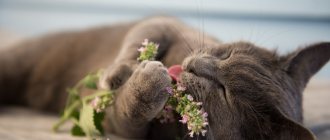When does a cat purr?
Purring is the first sound a kitten feels when it is born. Being born blind and deaf, he understands by vibration where his mother is and where he needs to move. No one explains to a kitten how to learn to purr - he understands it on an instinctive level. It is not difficult for cats to create this vibrating sound - it is produced by exhaling, and not by inhaling, unlike, for example, meowing. A cat can purr and rub against its owner's legs at the same time, thus showing its good mood. Sometimes a cat purrs on the veterinary table, seeing the owner’s concern for her. In this way she tries to calm the person down. During heat, the cat also purrs, but it is more like a mixture of meowing and popping sounds made by the vocal cords. When the male hears this sound, he understands that the cat is ready to mate. Rumbling for a cat is another way (besides the usual meowing) to express its emotions.
How can a person learn to purr like a cat?
Having understood the physiology of cats, you can try to transfer this knowledge to the human body. Is it possible to create such sounds with the help of our body? Unfortunately no.
The vocal cords of cats and humans are very different.
A person will never be able to purr like a cat because of the structure of the vocal cords - they are very different. Cats contract the muscles in their larynx, which moves their vocal cords. The process occurs instinctively, unconsciously, and it is impossible to learn.
Sound simulation
A person will not be able to purr like a cat, but you can imitate this sound. After all, a person is very good at imitation, and if he sets a goal, he can purr quite believably.
You should try saying "murrr" by vibrating your throat as you pronounce the "r". Do not cut off the word, but extend the sound as long as possible. As long as the lungs are enough.
It’s much easier for cats in this regard - they can purr both when exhaling and when inhaling. That is why their rumbling does not stop.
The most important nuance in learning is the pronunciation of this drawn-out, throat-vibrating “r”. She needs to burr in the French manner. The technique is discussed in more detail in the article “how to learn to burr p.”
It is clear that the results will only vaguely resemble the purring of a cat, but this is all that human ligaments are capable of.
What are the benefits of purring?
There are opinions that purring has benefits and has a positive effect on the human body. The main ones are:
- soft sound with a special timbre, frequency 27-44 Hz, has a healing effect on the body;
- purring has a positive effect on the health and condition of bones;
- has a calming effect on a person;
- helps get rid of stress and relieve fatigue after work;
- sound vibrations affect human brain activity and help normalize blood pressure;
- a massage can be compared to an acupuncture session.
Some of these misconceptions have no scientific basis and are simple myths that have taken root in society. Having a cat in the house can have a positive impact on a child's development. According to statistics, children who had animals in childhood treat them better.
Interesting facts about cat purring
There are many interesting facts on this topic that few people know:
- There are situations in history when a pet could imitate simple monosyllabic sentences while purring. Of course, this is simple, but this fact is still quite unusual and interesting.
- Cats “talk” only when completely alone or in the presence of a person. If two animals are in the same room, they do not need this type of communication.
- Purring can be beneficial not only for the cat, but also for the owner. The sounds and vibrations of cats when you pet them have a beneficial effect on the human body: headaches, fatigue, apathy go away, even blood pressure can stabilize in some cases.
- When an animal purrs, the veterinarian cannot listen to the heartbeat; it simply cannot be heard. Therefore, doctors wait until the cat calms down or turn on the water to distract him.
It doesn’t matter how loudly or how long the pet “talks”, what matters is that it does it. After all, in this way a cat shows you its love, appreciation and trust. The animal thanks you for feeding, treating and caring for it in general.
Important Points About Cat Training
The most important rule that a cat owner must understand is that the animal cannot be forced to follow commands. If you force a cat, it will become nervous and resist, so only positive motivation is the only possible one in the training process.
Treats are the best reward for a cat.
Cats respond best to treats. You can purchase special treats at a pet store, or prepare your own reward. Note that the pieces must be really small so that the animal does not get full ahead of time and lose interest in the learning process.
What treat should you give during training?
Training a cat is a long process. It is impossible to teach a pet many commands in one day, and if the owner tires the animal too much, then the training will cause him disgust and persistent resistance. Therefore, the best option would be to train your cat every day for ten to fifteen minutes.
It is important to gain the cat's trust in the person. Therefore, it is better to act as a trainer to the family member to whom the pet shows great affection. Trust must not only be gained, but also maintained. It is strictly forbidden to shout at a cat, much less physically punish it. Negative emotions during the training process are unacceptable. If the cat does not understand the command or refuses to follow it, you need to postpone training until a more favorable time.
The commands that the animal learns must always be repeated the same way, in an even, calm voice, without changing the intonation. Domestic cats remember words faster in their unchanged form and are sensitive to the timbre and emotions in a person’s voice.
Video – Yuri Kuklachev: Teaching a cat tricks
Which cat breeds are the best to train?
Absolutely any cat can be taught a variety of tricks and commands, since representatives of the feline family have an extraordinary strong intellect. But, it is possible to identify breeds whose representatives are distinguished not only by their special intelligence, but also by their temperament, which is most suitable for training. We present to your attention several breeds of cats that are characterized by curiosity, easy-going nature, affection for humans and sociability.
Which cats are easier to train?
Table 1. Top smartest cat breeds
| Breed | Description |
Scottish fold cat | Representatives of this breed love active outdoor games, enjoy communicating with people, and are easy to train. They are able to remember more than a dozen commands and perform various tricks perfectly. |
Thai | Active cats that maintain mobility and interest in life even in old age. They have a good memory and are able to distinguish a wide range of human intonations and different voice timbres. |
Cornish Rex | Incredibly gentle, curious and loyal to humans cats. They prefer close contact with the owner, are ready to participate in all family matters, and are excellent learners. Playful, the best motivation for them is the affection of their owner. |
Turkish van | Emotional, fearless and strongly attached to the owner of the cat. They quickly understand what a person wants from them and are able to learn many tricks. They have a flexible psyche and a high ability to adapt to different situations. |
Abyssinian cat | An intelligent, very active breed with a great ability to self-learn. Many owners of Abyssinians note that these cats instantly learn to open doors, press light switches, and enjoy mastering special logic toys. |
Burmese cat | Cats of this breed are very social, love human company and are not at all afraid of guests. They train well, enjoying communication with the owner and encouragement. |
Canadian Sphynx | Gentle, graceful and intelligent cats with great affection for humans. Sphynx cats can understand and remember many words and sentences, they always want to please a person, they are well trained, and are not touchy. |
Bengal cat | Incredibly flexible, active and intelligent cats, which can be called “cat-dog”. They are ready to follow a person everywhere, playful, friendly, focused on close contact with the owner, and easy to train. |
Which other member of the cat family can purr?
Once you understand how cats purr, it is not so difficult to understand which of their wild relatives is capable of emitting similar sound vibrations. Large cats differ not only in the shape of the hyoid bone, but also in the elasticity of the ligaments. Only the group of small cats has the most flexibility: cheetahs, ocelots and lynxes; they can make purring sounds.
Despite physiology, there are exceptions. Purring large predators include snow leopards, pumas, clouded leopards and leopards. Given the structure of the larynx, their ability is a real mystery.
Theories about the nature of purring
When kittens are born, they are already purring. They also do this in the process of sucking the mother’s milk, which has a calming effect both on her and on the “babies” themselves. Where did this purring come from?
Vocal cords
The cat's vocal cords vibrate, followed by the hyoid bones. From them the vibration moves to the whole body, so it seems that the cat is “groaning”
Paying attention to a purring cat, you will notice that she does this regardless of inhalation/exhalation of air. Thus, the conclusion suggests itself that purring is a vibration of the hyoid bones and all muscles of the body, and not a sound produced by an animal
Cat massage
There are many guesses why the pet purrs and tramples its owner with its paws. Here are some of them:
- Memories of childhood, or “milk step” - kittens knead their mother with their paws while feeding to quickly obtain milk. This brings them pleasure and is associated in adults with a feeling of comfort, satiety and security.
- Prepares a comfortable place to sleep - tramples the surface on which you are going to sleep for the greatest comfort. The owner's knees may well be suitable for this purpose.
- Gratitude - in this way one can say “thank you” for delicious food, warm shelter, tenderness and affection.
- Therapeutic massage is a common theory that this is how a cat treats its owner from ailments.
- Stress relief – by purring and moving their paws, cats lift their spirits, relax and calm down.
- Unfulfilled sexual instinct - one theory says that if an animal does not have a mate, it may show unambiguous interest.
- Marks its property - cats have glands on their paw pads that secrete a secretion. This is one of the ways to convey to other animals that a person belongs to him.
- Showing trust and love - the pet shows its owner its location, favor, openness and trust. Emphasizes your closeness with a person.
This massage soothes, relaxes and helps relieve stress. But what if claws are used? You can lightly press the cat towards you so that he lies down and stops trampling. You should not scold or drive out an animal if its trust and peace of mind are valuable. It’s better to just put a blanket or pillow on your knees in advance.
Reference! A cat will reflexively retract its claws if you stroke the top of its paws.
Cat-human interaction
The way a cat purrs depends on the person. A purring pet can trample its paws on its owner, lie down on top or next to it. All these actions have their explanation.
Showing affection
If you stroke your mustachioed pet, he will soon begin to purr. This means that he enjoys touch and communication with a person. When stroking against the grain or by a stranger, you can see the opposite effect. The animal will be angry or frightened and will hasten to leave with a threatening hiss.
Foot trampling
The most popular interpretation of trampling is the “milk step”. Kittens make similar movements on their mother's chest, stimulating the faster production of milk. Fingering with paws is also associated with:
showing gratitude and demonstrating trust in a person;
unrealized sexual instinct in castrated animals;
treating the owner or relieving one’s own stress;
preparing a comfortable place to sleep.
If your pet releases its claws when trampling, do not scold it. He does not control this action, so pet him and place a thick blanket or pillow under his paws.
Lying on or next to a person
Lying nearby is the highest form of trust and love. The animal feels safe with its two-legged owner. If a person is unwell, a furry pet can lie on top, sending its healing vibrations to the sore spot.
Why does a cat purr to a person?
For a long time, scientists have struggled with the mystery of the mechanism of a cat’s purring. They were looking for the organ in cats that produces its magical rattling sound. And since they didn’t find it, there was even an assumption that cats purr... with their stomachs.
Now the picture seems to be clearer. According to the most recent version, a cat's purr occurs as a result of contraction and vibration of the muscles located near the vocal cords, after corresponding impulses are received from the animal's brain. The complex system involves the hyoid bones, the nose, and the purring mouth.
That is, by and large, a cat’s “musical instrument” is located in its head - between the bases of the skull and tongue. And the belly has nothing to do with it, although the vibration from the purring goes throughout the cat’s entire body - even every non-cat person knows this!
How do animals purr?
The vocal cords are equipped with a group of muscles located nearby in the larynx. They allow cats to make characteristic sounds when inhaling and exhaling. The work of these muscles is controlled by brain impulses. Cat purring is an ability unique to felines and no one else in the natural world. Close relatives - lions and leopards - express their pleasure more often with other sounds. It's a snort, a low growl.
When do they purr?
There are many situations that cause a cat to reproduce a characteristic purr. These include:
- A newly born blind and deaf kitten finds the nipple by the purring of its mother, the vibrations of which it feels with its body. During feeding, the cat becomes silent.
- During the period of estrus, the animal calls its mating partner with characteristic sounds of a different tonality, but reproduced according to the same principle - with the help of additional muscles in the larynx.
- Comfortable communication between a cat and its owner, friendly individuals, and its own litter is always accompanied by purring.
- Satisfaction with life after a hearty meal is also a reason to purr.
The sounds made by animals, including the purring of cats, are studied by bioacoustics.
There is an opinion that a cat purrs not only when it is happy, but also to relieve its own stress. Scientists have suggested that cats purring is not always a sign of satisfaction or pleasure. In addition to its utilitarian purpose in matters of feeding offspring and attracting a mate, purring is used by cats to relieve their own stress. There is a known case where a cat was taken from home to another place located 3 km away. The animal did not like the situation and ran away. Having found its home only 10 days later, the cat walked around the house and purred all day. It has also been observed that cats purr when they are sick. Apparently, these sounds also heal the animal itself.
Purring heals
Everyone also knows that cats purr with pleasure when everything is fine with them - their belly is full, it’s calm, it’s warm, and their owner gently strokes their fur. But the mustachios turn on their motor and in moments of trouble and pain - giving birth cats, injured and even dying animals purr.
This fact, by the way, confirms the theory about the healing properties of a cat’s purring. There is an assumption that a purring cat produces a certain hormone that acts on the animal as an analgesic and sedative. And some owners claim that their pet’s purring helps them get rid of pain and malaise.
By the way, this is how the continuous vibrating cat sound differs from the short purring - the same one for which Kuprin’s Yu-yu became famous. Do you remember how she interacted with the owners? Her short “murrm” meant “follow me,” “mrm” meant gratitude, “mrum” meant “I’m thirsty,” and “murrum” meant reproach. These sounds are similar to meows and are used by cats to communicate.
The therapeutic effect of purring
Experienced owners say that cats sense illness, and if the pet always sits on its stomach or chest, you should consult a doctor.
Psychologists distinguish such a concept as feline therapy - a method of treating or preventing various diseases through contact with a cat. Its effectiveness has been confirmed by numerous experiments.
Thus, American scientists have found that when a cat purrs, a person’s blood pressure and pulse normalize. And Russian zoologists have found that cat owners, according to statistics, live several years longer and suffer 20% less from problems with the cardiovascular system.
Today, feline therapy is especially popular for the treatment of diseases such as depression, anxiety, irritability and stress, and migraines.
Where is purring born?
Not so long ago, zoologists tried to find an answer to the question of how cats purr . It was believed that this sound was born from vibrations of the diaphragm or trachea; there was even a theory that cats purr using their stomachs. The reason that did not allow zoologists to find out the truth is simple - the studies were carried out on immobilized cats, that is, at the moment when they did not purr.
After New Orleans zoologists changed their research method, they learned how cats purr and where the sound comes from . By conducting studies in natural conditions and using various modern sensors and microphones, they were able to find out why actually purr . The cat's throat contains "false" vocal cords - movable folds that function during inhalation and exhalation. After air enters from the lungs or the environment, vibrations appear on the mucous membrane, and the laryngeal muscles make the sound louder.
Why do cats purr?
Thinkstock
Many contented cats purr when in contact with a person or another cat.
For cat lovers, a cat's purr is one of the most exquisite sounds on earth. The joyful and soothing purr of a cat can calm us down in the midst of stress and relax us when we need to unwind. All cats - domestic and wild, big and small - are engaged in this mysterious activity. But why? Read on to find out.
How Cats Purr
In domestic cats, purring occurs during inhalation and exhalation as air passes through the glottis (the space between the vocal cords). The pause between them is so short that it makes the purring sound seem as if it were one continuous hum. While the specific mechanics of purring are still a mystery, one theory is that a rise and fall in pressure occurs as the glottis opens and closes, causing the vocal cords that produce sound to separate.
Why do cats purr?
Feeding, satisfaction and sexual relations are some of the conditions under which cats may activate their motor. Kittens purr while nursing as they knead their mother's belly to stimulate milk production. They also purr when being groomed. Purring is a nurturing behavior that helps establish and maintain a close relationship between another cat and her kittens.
While cats may purr while resting comfortably in a warm place, it is more typical for them to purr when in contact with a person or another cat. But simple tactile contact with an inanimate object can also trigger a sound: your cat may be inclined to purr when pressed against a corner. walls or rolling on the carpet. Experts believe that such situations are often a sign of satisfaction.
In addition to purring during positive activity, cats also purr under duress. Fear, anxiety, stress, trauma and recovery are other circumstances that cause purring. Purring may be associated with maintaining comfort even in severe pain.
Whatever the reason, hearing a cat purr is one of the most relaxing activities imaginable. Purring has psychological and social benefits and can help restore your relationship with your cat.
More details on Vetstreet.com:
.
Learning to purr
But seriously, surround the cat with love and in a moment of peace, lie down next to him and gently stroke him. As soon as the cat begins to purr, the person should, breathing only through his nose, try to tune in to the cat's frequency and try to make a sound as similar as possible to purring. Don't be discouraged if all you get out is grunting at first. Over time, a persistent student will definitely succeed.
Hearing a person purr, the cat will probably feel even more love for him. Well, in the company of your own kind, you can always make a splash! But you can make everyone laugh and surprise, but it’s unlikely that you can heal. This secret knowledge is hardly transmitted along with the purring skill.
So good luck with your studies! And remember: all cats purr at the same frequency - 25 cycles per minute, and nothing else. And finally, a poem!
The cat doesn't purr
The absence of such sounds from a cat may not only be the result of heredity. Often it occurs due to character traits or a manifestation of resentment towards the owner. Perhaps this is a consequence of distrust of a person, a feeling of discomfort, a feeling that he has become superfluous in the family.
Often a cat does not purr and begins to behave this way after the arrival of a small child in the family. To attract attention to herself, she begins to do dirty tricks, which she has not done before. But the owners' reaction to this may be negative. Try to understand the reason for this behavior and show your pet patience and affection. Then the situation may change and you will again hear him purring gratefully.
Getting a tutor
But let's return to cat lovers who ask how a person can learn to purr like a cat. Unfortunately, no one will be able to repeat this wondrous rattling the first time - simply due to different anatomy. And a cat will not voluntarily reveal its secret of how to purr to a person. But you can use a trick.
First of all, in order to learn to purr, you need to get a personal mustachioed tutor, if you don’t already have one. Did you start it? Now do everything to appease him: buy him the best food, a house, a “sports corner”, toys, a scratcher and scratching post with catnip, a running wheel, a pair of beautiful carriers for traveling to different distances and proclaim him the ruler of the Universe.
How to determine a cat's desires by purring
Rubbing and purring?
She clearly needs something from a person, most likely food or she’s just bored. The timbre, amplitude, and volume of the purring reveals the different emotions and desires of the animal.
- A loud and worried rumbling indicates pain (injury or illness). It is necessary to observe the animal, establish accompanying symptoms and help it.
- Increased rumbling and active tail wagging indicate the animal's dissatisfaction. If the owner strokes the cat at the same time, it means that these actions must be stopped, she does not like it.
- A nursing cat protects her offspring with a loud purr and signals that no one should approach her or her kittens.
- A soft purr and closed eyes indicate the pleasure the animal receives.
- The cat purrs and rubs against the owner - it requires attention or treats.
Important: a cat can purr before dying.
The main reasons for a cat's purring
A cat purrs when it feels safe, but may also purr to relieve stress or pain.
A cat's purr is never without a reason. Purring expresses their emotional and physical state.
It is generally accepted that cats purr only when they are happy. Surely in most cases it is for this reason.
However, a cat's purring can also be detected when the cat is excited, scared, injured, before giving birth and at other exciting times. Why does she purr when he is stressed? In this way, the animal calms and heals itself.
To better understand the reason for purring, let’s look at the accompanying actions of the animal.
- It stomps its paws on or near a person and purrs. The animal marks its owner in this way, demonstrating its own importance.
- Rumbling when stroking indicates that the cat is receiving true pleasure.
- A loud, restless purr, similar to a tractor, accompanied by accompanying soft and cute movements, may indicate an injury to the animal. It is necessary to pay attention to whether she is experiencing a painful condition, whether she is trying to crawl out of the wound, whether she is experiencing discomfort and other disturbances in her general condition.
- The purr of a mother cat while feeding her cubs calms the babies.
- A cat may also purr after a tasty and satisfying meal and during a nap.
- A cat's purring can also be its anticipation of pleasant moments: treats, emotions, games.
- A caring pet may begin to purr, sensing the painful state of its owner, in an attempt to calm him down.
- A cat purring during a meeting with a veterinarian may indicate that the animal is stressed and trying to calm down.
Cats purr when communicating with their own kind.
In addition, cats also use purring when communicating with their own kind. If a cat purrs when meeting another animal again, this indicates that she is in a friendly mood. The purring of a cat during aggressive play or a fight with another cat is evidence that she is giving up and raising the “white flag”.
Rumbling can also express boredom, or a cat may begin to purr before a serious and responsible action, such as jumping from a high cabinet.
Scientists have not yet figured out the exact reasons for the start of the rumbling mechanism in mustaches.
Interesting: Cats can’t purr in their sleep, but they can easily purr during a nap.
What does purring mean?
An interesting fact is that the vibrating sound made by cats is the result of several factors.:
- manifestation of emotions. The kittens signal to the cat that everything is fine. Then the adult purrs and thereby tries to tell the owner about it,
- an expression of pleasure. This is a kind of sign of gratitude for delicious food, comfort and affection. In general, being in a good mood can be a reason to purr under your breath,
- calmness. This is a way to calm down after suffering stress, especially when stroked by the owner. After all, the kitten purrs when sucking its mother’s milk and this is a natural process. Therefore, an already adult cat calms down from the sound of its purring. Sometimes in this way he prepares himself for sleep. Then there is no loud purring, rather it will be quiet,
- a sign of threat or a mood to hunt. Purring can not only be kind and affectionate, it can sound quite aggressive. This is how the cat makes it clear that this is his territory. The hunter guarding the birds purrs loudly, tuning in to the hunting process.
If a cat never purrs, it may be due to his personality. Some individuals, like people, simply do not like to show emotions.
How does purring occur?
For a long time, the purring of cats remained a mystery to humans. And even now it is not fully studied.
Initially, scientists tried to find a separate organ that is responsible for producing vibrating sound. But nothing suitable was found. Then they decided that the sound was coming from the cats' stomachs! But they quickly rejected this misconception.
The modern official version is that purring occurs due to the contraction and vibration of muscles that are located near the vocal cords. This is caused by the arrival of certain impulses from the animal’s brain.
A number of systems are used to create such a unique sound:
- nose;
- mouth;
- hyoid bones;
- ligaments
Sound and vibration originate between the base of the skull and the tongue, and then spread throughout the body.
How do cats purr?
Who would have thought that such a seemingly trivial question could plunge “great minds” into complete stupor. Until recently, scientists were simply unlucky: they were unable to unravel the mystery of how and why pets make sounds.
Hypotheses
Some suggested that the whole issue was in the vibration of the diaphragm or trachea, other pundits generally blamed the cat's belly for everything. But the whole point is that it was not possible to solve the puzzle due to the examination of immobilized animals that did not make a single sound.
Why do cats crumple their claws when you pet them?
Some cats release their claws when they simply lie on their knees. And people often don't like it either. But this is not a form of aggression. This is how animals want to mark their owners. After all, under their claws they have secretion glands, which are secreted directly in order to mark their territory.
There is another theory about this. When you pet a cat, it relaxes, and therefore its muscles too. That's why the claws come out. This happens involuntarily. Every time a cat reaches, it extends its claws. And this is also a way of self-preservation. When a cat lies on your lap and is petted, it relaxes. But she cannot be sure that in 5 minutes she will not be thrown to the floor. Therefore, it is prepared in advance and if they start to drive it away, it will quickly be able to catch on a person’s clothing or the upholstery of a chair.
How to teach your cat circus tricks?
He can jump back and forth several times until he gets bored. He will either sit, disappointed, on the cabinet, or even jump to the floor. Return it to its place and give the command “Jump!” simultaneously with the gesture. He will jump. Encourage him verbally and with meat. Repeat immediately 2-3 times.
Another pause. And everything is new. And so on until the kitten, waiting for a command, calmly remains on the stand, without jumping anywhere.
One lesson is hardly enough for this. The kitten will most likely not understand anything the first time. If you notice that the animal is confused, stop the activity. In subsequent lessons, repeat the same thing until the student begins to jump only on command. (Don't forget about "kindergarten"!)
This is extremely important and determines the success of all further training of the animal. Having learned to perform one trick on command, the animal will get used to learning for the rest of its life and will master subsequent tricks more easily. Therefore, gather all your patience, all your will, but bring the first trick to complete stimulus control, sparing no time. It will be a struggle of characters - who will train whom. And cats have a very strong character...
Margarita Bogdanovskaya (7 years old), “Young trainer” Photo: magtu.ru
And now, finally, your kitten has completely mastered his first trick - he jumps from stand to stand on your command, and if he doesn’t receive a command, then he sits calmly on the stand. Don't demand too much, kittens are restless, don't try to force him to sit idle for more than 30 seconds. To develop the skill of sitting still, a separate training course is required.
What struck me most at the Cat Theater was one cat, which lay calmly throughout the entire performance on some arch above the stage like a living decoration. I took her for decoration, until at the end of the performance she came down at Kuklachev’s command. This is the ultimate in cat training! I couldn't do that.
And your kitten will have to learn a new trick - jumping through a hoop . A hoop with a diameter of 30-40 centimeters should be made of willow twig or thick aluminum wire in bright insulation so that it is clearly visible to both the kitten and the audience. Before starting training, you should introduce the animal to a new object by simply placing it on the floor and letting the kitten sniff it, without just allowing it to play with it.
In essence, this trick is no different from the first, it’s just that a hoop is placed between the pedestals - first at the level of the pedestals, and gradually rises higher and higher until the kitten has to work hard to fly through it. Don’t demand the impossible, remember that it is important to practice the trick, and increasing its parameters is always easy, especially as the animal grows.
I won’t describe in detail how to teach this trick - you already understand the essence of the process and can easily break it down into lessons yourself.
Let me draw your attention to a few points:
1. If you are going to perform this trick in the future using thumbs, then the command can be left the same as for jumping. And if you subsequently plan to teach the kitten to jump through a hoop from the floor or on the sofa, then the command should be different and the command gesture too. This needs to be thought out in advance; it will be difficult to relearn later.
2. To perform this trick more clearly and quickly, after you bring the skill under stimulus control, spend several lessons on the following: reward the kitten with the word “good” after each jump, but don’t always give the meat, sometimes, without any system, skip it. This is called varied reinforcement. It will make the animal think, and it will try to perform the trick better. And let him know for the future - real encouragement is praise, and meat is just an additional incentive.
3. Immediately remove the hoop after jumping, otherwise the kitten, not receiving meat, will begin to jump back and forth, forcing you to leave it without reward at all.
The next required trick is standing on your hind legs . For some reason, it is customary for trainers to use the “OFF” command for this trick, or in our language “Offchik”. When teaching this skill, hold a piece of meat between your palm and thumb, let the kitten smell the meat, and then raise your palm, causing the kitten to rear up. And say “Off” yourself, as you will be severely scratched by the sharpest claws.
Photo: guvo59, pixabay.com
When the kitten understands what they want from him, do not squeeze the meat anymore, hold your palm out of reach of the animal’s paws, and give the meat with the other hand. Meat should be given when the kitten is still standing on its hind legs, otherwise you will reinforce the lowering rather than the rearing.
It is better to perform this trick also on a cabinet; the cabinet disciplines a kitten in the same way that a child is disciplined in a classroom.
It’s up to you to decide what other tricks to learn with your pet: you can walk on a boom, you can jump over an obstacle, make a “snake” between your legs, give a paw, fall on one side, but you never know what comes to your mind. Now you and your kitten have become different: he has learned and loves to learn, and you love to teach.
Finally, I’ll give you two pieces of advice from the practice of professional trainers:
1. How to wean an animal from unwanted actions.
You need to spend several lessons, interrupting the training of the main trick, to consolidate the unwanted action and bring it under stimulus control. That is, you need to come up with a separate command for this undesirable action and ensure that this action is performed on command, and execution must be unconditional. After this, you can return to working on the interrupted trick - the unwanted action will now be performed only on command, representing a separate trick.
Photo: Depositphotos
2. How to teach an animal to experiment in order to make it jump higher, run faster, meow louder.
For this purpose, variable reinforcement that is already familiar to you is used: food reward not every time, but at irregular intervals.
- The animal performed the trick, received verbal encouragement (“good”), but did not receive any meat. Command again, he performs the trick again, this time getting both. Then several times he will get everything at once, and then two whole times he will not receive meat. And then he gets it three times in a row.
This regime of variable reinforcement is good to introduce into daily practice (of course, only for fully practiced tricks). And when the day comes that you need to increase the height of your jumps or the speed of your run, then you can calmly, without fear of upsetting and disappointing the kitten, not give him meat several times in a row, which will force him to try, experiment, try to understand what he is doing wrong . As a result, individual jumps will become higher, you can’t yawn here - you need to encourage the student to the fullest extent.
Charles Spenceley, “Kitten” Photo: artchive.ru
Well, that's all about kitten training. As your pet grows up, the “circus program” should be repeated regularly so that the animal does not become lazy. An encouragement for you personally will be the surprise of the audience, because many people have expensive cats, but only you .
Tags: cats, training, cat training, animal training
Why do we like this sound so much?
A person is often a very receptive creature with a subtle mental organization. When a cat comes to you and purrs, it is a sign that she is warm and comfortable next to you, that she feels safe and is not afraid of you. If we have a warm fluffy bundle of happiness and goodness next to us, then what else do we need? At least once in our lives, each of us has asked an unusual question: “How can I learn to purr like that?” Sometimes we feel so good and warm for various reasons that we just want to lie down next to our loved one, hug him and purr with happiness. We like this sound so much that we are ready to forgive our smaller brothers any mistakes and mischief, be it a torn sofa or a puddle in the most inappropriate place.
like a cat like a cat a person purrs a cat like a cat purrs a cat or a cat eats like a cat How a cat purrs like a cat to a person like a cat a sound that can vibrations that occur All cats purr when a cat or an organ that responds muscles that are located
breeds dogs capable of disease read content you











